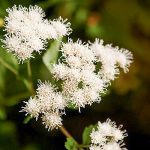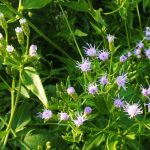These endearing plants excel in every way: freeze and heat hardy, bloom all fall and pleasing to pollinators!
Fall offers ideal gardening conditions for planting new WaterSaver Landscape Coupon beds. But be careful — autumn will roll into winter in the blink of an eye.
Start planning for your coupon bed as soon as possible. Although there’s a stunning array of plant options for your coupon bed, we want to spotlight a small but mighty species group: mistflowers.
The various species of mistflower are endearing in that they’re scraggly and cute. The petite flowers are reminiscent of a small child with unruly bedhead. These plants excel in every way: they’re freeze hardy, exceptional pollinator plants, drought tolerant, and fall bloomers.
Here are the three species of mistflower and what makes each of them unique.
White mistflower
 Clumps of small white puffy flowers define this species that is sometimes referred to as shrubby boneset. It’s an unusually spooky name for such a delightfully sprawling plant that can grow upwards and outwards as far as six feet. As an evergreen, this potentially large plant might be a great option to use as a screen or hedge, providing privacy while soft white flowers gently break up the mass of green. Keep an eye out on our native areas and parks for white-flowered shrubs on the hillsides over the next four weeks.
Clumps of small white puffy flowers define this species that is sometimes referred to as shrubby boneset. It’s an unusually spooky name for such a delightfully sprawling plant that can grow upwards and outwards as far as six feet. As an evergreen, this potentially large plant might be a great option to use as a screen or hedge, providing privacy while soft white flowers gently break up the mass of green. Keep an eye out on our native areas and parks for white-flowered shrubs on the hillsides over the next four weeks.
 A common sight in garden beds, the vibrant lavender blooms and unusual architecture make for interesting texture in the landscape. Many people’s first exposure to mistflower is when they’re surprised by one of these little plants covered entirely in butterflies. It makes a fantastic centerpiece in any coupon bed.
A common sight in garden beds, the vibrant lavender blooms and unusual architecture make for interesting texture in the landscape. Many people’s first exposure to mistflower is when they’re surprised by one of these little plants covered entirely in butterflies. It makes a fantastic centerpiece in any coupon bed.
Shrubby mistflower
 This sprawling small bush with pale purple flowers is the halfway point between white mistflower and Gregg’s mistflower. It’s a happy grower and will spread as far as it can when given the opportunity. Considering its unruliness, most people prune shrubby mistflower back to the ground once a year, generally in March, to tidy it up and keep blooms fresh.
This sprawling small bush with pale purple flowers is the halfway point between white mistflower and Gregg’s mistflower. It’s a happy grower and will spread as far as it can when given the opportunity. Considering its unruliness, most people prune shrubby mistflower back to the ground once a year, generally in March, to tidy it up and keep blooms fresh.
As you begin to consider where and what you want to plant with your WaterSaver coupons, think about tossing some mistflower in the mix.
Whether you’re a bereaved “black thumb” like me, a fiend for flora that supports fauna, or a decidedly do-nothing denizen, the mistflower will be right at home in your garden!


